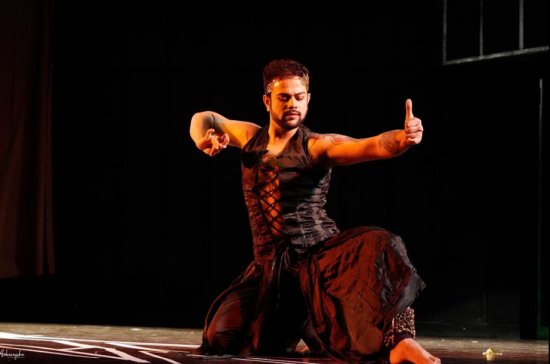
|   |

|   |
Indian dance coming of age - Kasturika Mishra e-mail: kasturikafeministpoetry@gmail.com July 5, 2024 Dance theatre production 'Echoes of Narciss-Us' premiered on 26th of June 2024 at the Stein Auditorium, India Habitat Centre, New Delhi. Mirror for a narcissist is a simple lie. A narcissist refuses to accept all that is negative in him as hard truth. A profound sense of false pride, dishevelled lost glory and an enticing external demeanour is always to be looked at from an angle of doubt and deprivation by a narcissist. As they say, a mirror never lies. So does Sudip Chakraborty when he attempts yet another classic since his last choreographic presentation on Macbeth from Greek literature. The original text is adapted from the western counterpart into Indian setting utilizing Kathak, Bengali, Hindi and Urdu poetry to create the dramatic elements. Narcissus's mother played by Ambali Praharaj, an astute theater actor from Kolkata is the opening sequence. The anomaly on the birth of Narcissus and the sakhis taking turn to appreciate the remarkably handsome child is a lovable spot on choreography. The high point is use of Baul song "Khachar vitore achin pakhi" where the prophetic English voice announces, "May he fall in love denied once"! The scenario is followed by a tarana in raag Hamsadhwani wherein the mother is seen protecting her son from the prophecy and avoiding his interaction with reflective surfaces. Little did she realize that the emptiness of self would kill her son and she could not be the protector in all instances. A bevy of young dancers accompanied Sudip this time as a possible repertory company of his own. A group production always brings in freshness to any production and each of these young dancers, specially Mansi Kumari and Deepanshu Tyagi, shone in their first public performance.  All leading solo dancers whether senior or junior in India have supporting cast as it's nearly impossible to survive the pressure of funding solo acts and also portray any single dance form. Moreover, the amount of chivalry and hero worshipping expected from juniors is so high that one wonders how and when Indian dance will come of age. Government platforms and promoters prefer sycophants and junior artistes are trying to build castles out of the traditional mould and subjects. Youngsters like Sudip who are convent educated and also well read in comparison to the last generation have the capacity and thirst to break the glass ceiling only if, I emphasize, they are not strangulated culturally. Times are changing so the sensibility of all art forms need a holistic makeover, not a cosmetic back-patting while actually amounting to back stabbing. Coming back to the choreography part, the mother is seen teaching Narcissus to dance, learn archery, aim at his prey and feed animals. Alas, her attempts go for a toss when her son with a split personality encounters amorous advances from young lovers. He entices them to extremely passionate relationships soon to leave them to lose their sanity and drive his lovers to lunacy. Narcissus loves a lady and a boy, maybe he was bisexual. In the bisexual interpretation, Sudip deftly utilizes two raw ballet dancers to display the amorous love play between lovers and how heartbreak leads to despair. Ashes are smeared on the faces and body as the besotted lovers perish when conned by the love of their life. Soon the protagonist is lost in the jungle trail. He calls out for help and direction. While wandering and reaching river Lamos he encounter his own self-image. Unaware of any mirror, he falls for his own charm and beauty. He implores to be loved in return but no one comes around. Sudip uses Urdu couplets like "Hazar baar chale hum hazaar baar ruke", Bengali poem like "Bipasha amra naahi mitalo" to highlight lovelessness. He gets no respite from whining and tossing in the path to self-deprecation. In this moment, the group of dancers merge in and out of joyful ecstasy of meeting an enchanting handsome man and getting dejected. Empty handed, emotional succour missing in a suicidal moment, and reaching the zenith of admiration and relief, Narcissus embraces death as solace. Due to the tight timing of texts and dance, it took a while to digest the fast pace of scenes but this can easily be corrected in next shows. Our new age dancers are moving closer towards an international arena, over crossing the barriers of language, literature and experimenting with these kind of amalgamated productions. They are a far cry from their blue rooted seniors still dabbling in stories of Indian mythology and spirituality. It's about time to think out-of-the-box to fix and touch newer horizons. Sudip and his team of artistes deserve a wider audience and applause!  @Kasturika Mishra is a poet, writer, and dance critic. |